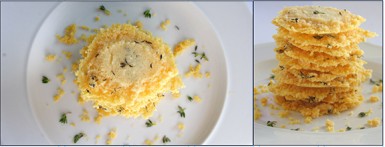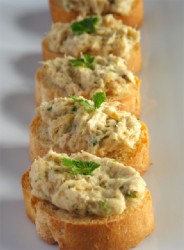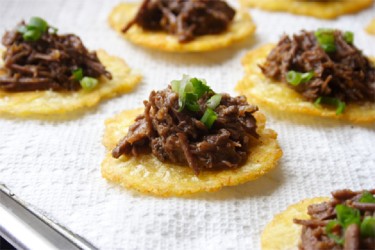Generally speaking, the way we present our food here in the Caribbean does not come as a 3-course meal; rather it is served in 2 courses – the main/entrée (which would also include a variety of side dishes and what in other cuisines would be referred to as appetizers). The second course is dessert. It is only when we are formally entertaining that we tend to separate the food into more than 2 courses.
Many people use the holidays to really let their entertaining skills shine in the kitchen and at the front of the house. An appetizer is usually the first course of a meal and is typically designed to complement the rest of the meal. In other words, whatever you prepare to serve as an appetizer should complement either by flavour, texture, etc, whatever you plan to serve as side dishes and main/entrée. However, we need not be this straight-laced, after all, it’s the holidays right? My advice is to go with the flow, work with what you have and what suits you, your family and friends. The only thing you need to keep in mind for an appetizer is this – it is the entrance to the rest of your feast, make it tasty and make it attractive. Remember, people eat with their eyes first.
A quick note here to appease the entertaining gurus and aficionados, there is a slight difference between hors d’oeuvres and appetizers. A hors d’oeuvre is a one-bite item; this means you put all of it into your mouth at one time. It’s bite-size. Hors d’oeuvres are finger foods. Appetizers on the other hand appear as first courses when you sit down to a meal. They are slightly larger, meaning that they require more than one bite and like I said before, they are often composed to complement the rest of the meal.

Since we are in the Caribbean, let’s call these, small bites. Use the yields only as a guide and the recipes are easy to double. The amount you make will always depend on the number of guests you are having at your gathering and the type of get-together. If it is a cocktail party then you will have to make more than if you are using these small bites as a start to a full meal of sides, mains etc. Be sure to read all the notes in the recipes, as they will assist you greatly.
Brandade de Morue
SPECIAL EQUIPMENT
- 2 – 3 saucepots
- Food processor or mortar and pestle
- Whisk
- Sauté/frying pan
- Stand/hand mixer

INGREDIENTS
- 1 pound boneless salt fish, soaked overnight in boiling water
- 1 bay leaf
- 2 sprigs fresh thyme
- Water
- 1 head of garlic, roasted
- ½ cup heavy cream
- ½ cup canola oil, divided in half
- 1 tablespoon minced parsley
- ½ teaspoon freshly grated nutmeg
- ½ teaspoon lemon juice
- Freshly ground white or black pepper to taste
DIRECTIONS
- Remove the salt fish from the water it has been soaking in overnight, place in a saucepot with fresh water along with thyme and bay leaf and bring to a boil for 15 – 20 minutes (it is important that the fish retain enough of its salt to taste and season the dish).

Tostones with Shredded Stewed Beef (Photo by Cynthia Nelson)
- Drain the boiled salt fish, and pat dry. Discard bay leaf and thyme springs. Using a food processor, mortar and pestle, or your fingers, pulse to shred or pound the salt fish very finely. Set aside.
- Squeeze the pulp of the roasted garlic from its casings and mash until creamy.
- Add cream and mashed garlic to a saucepot and whisk gently mixing the two ingredients. Place pot on low heat and warm gently; do not let the mixture come to a simmer or boil, you only need it warmed.
- Add ¼ cup of oil in another saucepot and warm gently over low heat.
- Meanwhile, heat the remaining ¼ cup of oil in a sauté/frying pan on medium heat. Add shredded salt fish, reduce heat to low and stir, mixing until the salt fish has absorbed the oil, keep stirring and mixing for another 1 – 2 minutes. Remove the pan from the heat.
- Remove the other saucepots with cream mixture and oil also from the heat.
- If you’re working with a stand/hand mixer, add the salt fish to the bowl, turn the mixer to medium speed and gradually add the cream mixture and the heated oil to the salt fish, by alternating the cream and the oil. Be sure that the cream and oil are fully incorporated at each stage before adding another set. Keep adding and alternating until all the cream and oil have been added to the salt fish. The desired consistency is that of a creamy paste. If you are working by hand, using a whisk or wooden spoon, you have to stir constantly to mix in the liquids in order to attain the texture and consistency.
- Season the mixture by stirring in the nutmeg, lemon juice, pepper and parsley. Taste for salt and add if necessary, however, there should be enough salt from the salt fish.
- Serve with toast points (sliced bread cut into triangles and toasted) or toasted baguette.
NOTES
- This dish can be served as a dip – add more heated cream and oil to the mixture to give it that dip like consistency
- Boiled and mashed potatoes can be added to give the dish more body, however, adding too much potato can dilute the wonderful salt fish flavour.
- Turn this dish into au gratin by sprinkling the top with seasoned breadcrumbs (simply add some finely chopped fresh herbs) and drizzles of oil. I’d suggest moistening the breadcrumbs with the oil and then sprinkling it on top for even browning.
- This recipe will work for 24 thin slices of baguette bread.
Tostones
SPECIAL EQUIPMENT
- Heavy-bottomed pan (such as cast iron or other kitchen item that can be used to flatten something cooked.
- Plastic wrap.
INGREDIENTS
- Green plantains, peeled
- Oil
- Salt
DIRECTIONS
Method – Appetizer
- Cut plantains into ½ or 1-inch thick rounds.
- Heat 1-inch of oil in a frying pan on medium heat until hot but not smoking.
- Fry plantains in batches. While still hot, place 1 piece of plantain at a time between plastic wrap and using something heavy with a flat bottom, smash, flatten the plantain and set aside. Repeat until all are smashed.
- Reheat oil and fry until golden and the edges crisp. Drain on paper towels and season with salt.
- Serve as is, with a dip or condiment, side dish or as an appetizer topped with something.
APPETIZER TOPPING SUGGESTIONS
- Sautéed ground beef, lamb, pork or chicken with herbs
- Chopped ham
- Cooked and shredded garlic pork
- Shredded meat from a stew/braise
- Guacamole
- Fresh tomato salsa
- Smoked salmon & sour cream with chives
- Scrambled eggs
- Curried baby shrimp
Parmesan Crisps
Yield: 18 – 20
SPECIAL EQUIPMENT
- 18” x 13” baking sheet (or use whatever you have)
- Parchment paper
INGREDIENTS
- 2 cups grated Parmesan Cheese
- ½ tablespoon fresh thyme or rosemary, finely
chopped
DIRECTIONS
- Preheat oven to 400 degrees F.
- In a bowl, add cheese and thyme or rosemary, if using, and mix together with fork.
- Place 2 level tablespoons of mixture on the baking sheet about 2 inches apart, spread lightly so that there isn’t a mound.
- Bake for 4 – 5 minutes or until golden and stuck together.
- Remove from oven and let crisps firm up before transferring to serving platter.
NOTES
- Because this appetizer is very simple and uses few ingredients, be sure to get the best quality of ingredients.
- The cheese will not melt and become smooth but it will melt enough to stick/hold together.
- To make a larger crisp to serve as a bowl, take an additional ½ cup of grated cheese and spread on baking sheet; bake for 5 – 6 minutes or until melted and golden, quickly remove from pan with a spatula and drape over a bowl turned upside down. Let cool until hardened.
- These pair well with chilled fruity white wines.





